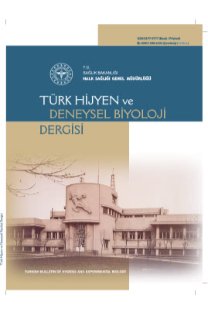pH duyarlı hidrazon bağıyla mPEG-b-PCL kopolimerine konjuge edilen doksorubisin miktarının belirlenmesi
Determination of doxorubicin amount conjugated to mPEG-b- PCL copolymer via pH sensitive hydrazone bond
___
- Pasut G, Scaramuzza S, Schiavon O, Mendichi R, Veronese FM. PEG-epirubicin conjugates with high drug loading. J Bioact Compat Polym, 2005; 20 (3): 213-30. doi:10.1177/0883911505053377.
- 2. Bagherifam S, Skjeldal FM, Griffiths G, Mælandsmo GM, Engebråten O, Nyström B, et al. pH-responsive nano carriers for doxorubicin delivery. Pharm Res, 2015; 32: 1249-63. doi: 10.1007/s11095-014-1530- 0.
- 3. Kavand A, Anton N, Vandamme T, Serra CA, Seng DC. Synthesis and functionalization of hyperbranched polymers for targeted drug delivery. J Control Release. 2020; 321: 285-311. doi.org/10.1016/j. jconrel.2020.02.019.
- 4. Malikmammadov E, Hasirci N. Dual- and Multistimuli-Responsive Polymers for Biomedical Applications. In: Aguilar MR, Román JS, eds. Smart Polym their Appl. Second Edi. Woodhead Elsevier Ltd, 2019: 255–78. doi.org/10.1016/B978-0-08- 102416-4.00008-9.
- 5. Li Y, Yang HY, Thambi T, Park JH, Lee DS. Chargeconvertible polymers for improved tumor targeting and enhanced therapy. Biomaterials, 2019; 217: 119299. doi.org/10.1016/j. biomaterials.2019.119299.
- 6. Chang M, Zhang F, Wei. Smart linkers in polymer-drug conjugates for tumor-targeted delivery. J Drug Target, 2016; 24: 475-91. doi: 10.3109/1061186X.2015.1108324.
- 7. Faal MM, Jafari A, Mirhadi E, Askarizadeh E, Golichenari B, Hadizadeh F, et al. Endogenous stimuli-responsive linkers in nanoliposomal systems for cancer drug targeting. Int J Pharm, 2019; 572: 118716. doi.org/10.1016/j.ijpharm.2019.118716.
- 8. Sahin A, Eke G, Buyuksungur A, Hasirci N, Hasirci V. Nuclear targeting peptide-modified, DOXloaded, PHBV nanoparticles enhance drug efficacy by targeting to Saos-2 cell nuclear membranes, J Biomater Sci, Polym Ed, 2018, 29, 507-19. doi.org/ 10.1080/09205063.2018.1423812.
- 9. Etrych T, Subr V, Laga R, Rihova B, Ulbrich K. Polymer conjugates of doxorubicin bound through an amide and hydrazone bond: Impact of the carrier structure onto synergistic action in the treatment of solid tumours. Eur J Pharm Sci, 2014; 58: 1-12. doi: 10.1016/j.ejps.2014.02.016.
- 10. Lale SV, Kumar A, Naz F, Bharti AC, Koul V. Multifunctional ATRP based pH responsive polymeric nanoparticles for improved doxorubicin chemotherapy in breast cancer by proton sponge effect/endo-lysosomal escape. Polym Chem, 2015; 6: 2115-132. doi.org/10.1039/c4py01698j.
- 11. Xiong W, Peng L, Chen H, Li Q. Surface modification of MPEG-b-PCL-based nanoparticles via oxidative self-polymerization of dopamine for malignant melanoma therapy. Int J Nanomedicine. 2015;10: 2985-96. doi: 10.2147/IJN.S79605.
- 12. Mariani E, Lisignoli G, Borzì RM, Pulsatelli L. Biomaterials: Foreign bodies or tuners for the immune response? Int J Mol Sci, 2019; 20: 636. doi: 10.3390/ijms20030636.
- 13. Öz UC, Bozkır A. Polimerik veziküller ve biyolojik uygulamaları. Turk Hij Den Biyol Derg, 2018; 75(4): 443-58. doi:10.5505/TurkHijyen.2018.87369.
- 14. Gong CY, Wang YJ, Wang XH, Wei XW, Wu Q, Wang B, et al. Biodegradable self-assembled PEGPCL- PEG micelles for hydrophobic drug delivery, part 2: In vitro and in vivo toxicity evaluation. J Nanoparticle Res, 2011; 13: 721-31. doi:10.1007/ s11051-010-0071-7.
- 15. Hu C, Chen Z, Wu S, Han Y, Wang H, Sun H, et al. Micelle or polymersome formation by PCL-PEGPCL copolymers as drug delivery systems. Chinese Chem Lett, 2017; 28: 1905-9. doi.org/10.1016/j. cclet.2017.07.020.
- 16. Chen Y, Zhang YX, Wu ZF, Peng XY, Su T, Cao J, et al. Biodegradable poly(ethylene glycol)-poly(ϵ- carprolactone) polymeric micelles with different tailored topological amphiphilies for doxorubicin (DOX) drug delivery. RSC Adv, 2016; 6: 58160-72. doi.org/10.1039/C6RA06040D.
- 17. Isik G, Hasirci N, Tezcaner A, Kiziltay A. Multifunctional periodontal membrane for treatment and regeneration purposes. J Bioact Compat Polym, 2020; 35: 117-38. doi. org/10.1177/0883911520911659.
- 18. Wang F, Wang YC, Dou S, Xiong MH, Sun TM, Wang J. Doxorubicin-tethered responsive gold nanoparticles facilitate intracellular drug delivery for overcoming multidrug resistance in cancer cells. ACS Nano, 2011; 5: 3679-92. doi.org/10.1021/nn200007z.
- 19. Ye WL, Zhao YP, Li HQ, Na R, Li F, Mei Q, et al. Doxorubicin-poly (ethylene glycol)-alendronate self-assembled micelles for targeted therapy of bone metastatic cancer. Sci Rep, 2015; 5: 14614. doi: 10.1038/srep14614 .
- 20. Guo X, Shi C, Wang J, Di S, Zhou S. pH-triggered intracellular release from actively targeting polymer micelles. Biomaterials, 2013; 34: 4544-54. doi.org/10.1016/j.biomaterials.2013.02.071.
- 21. Gatti S, Agostini A, Palmiero UC, Colombo C, Peviani M, Biffi A, et al. Hydrazone linked doxorubicin-PLA prodrug nanoparticles with high drug loading. Nanotechnology, 2018; 29: 305602. doi: 10.1088/1361-6528/aac0d3.
- 22. Song H, Wang R, Xiao H, Cai H, Zhang W, Xie Z, et al. A cross-linked polymeric micellar delivery system for cisplatin(IV) complex. Eur J Pharm Biopharm, 2013; 83: 63-75. doi.org/10.1016/j. ejpb.2012.09.004.
- 23. Etrych T, Jel´ınkova M, Rihova B, Ulbrich K. New HPMA copolymers containing doxorubicin bound via pH-sensitive linkage: synthesis and preliminary in vitro and in vivo biological properties. J Control Release, 2001; 73: 89-102. doi: 10.1016/s0168- 3659(01)00281-4.
- 24. del Rosario LS, Demirdirek B, Harmon A, Orban D, Uhrcih KE. Micellar nanocarriers assembled from doxorubicin-conjugated amphiphilic macromolecules (DOX-AM). Macromol Biosci, 2010; 10: 415-23. doi: 10.1002/mabi.200900335.
- 25. National Center for Biotechnology Information (2021). PubChem Compound Summary for CID 31703, Doxorubicin. Retrieved May 24, 2021 from https://pubchem.ncbi.nlm.nih.gov/compound/ Doxorubicin
- 26. Configliacchi E, Razzano G, Rizzo V, Vigevani A. HPLC methods for the determination of bound and free doxorubicin, and of bound and free galactosamine, in methacrylamide polymer-drug conjugates. J Pharm Biomed Anal, 1996; 15: 123- 29. doi: 10.1016/0731-7085(96)01825-0.
- ISSN: 0377-9777
- Yayın Aralığı: 4
- Başlangıç: 1938
- Yayıncı: Türkiye Halk Sağlığı Kurumu
COVID-19 maliyetleri; Türkiye’de bir il örneği
Hüseyin ASLAN, İsmail ŞİMŞİR, Elif KÖSE, Gülsen TOPAKTAŞ
Ayşen TEZCANER, Nesrin HASIRCI, Aysel KIZILTAY, Gülhan IŞIK
Zahra SOHRABI, Vahid RAISSI, Gita ALIZADEH, Soudabeh ETEMADI, Omid RAIESI, Mohammad Reza BAGHERPOOR, Zahra Babaei SAMANI, Fatemeh PARANDİN, Zeinab HASHEMIBAGHI, Asmaa IBRAHIM
Gülizar AYDOĞDU, Çağlar ADIGÜZEL, Hakkı TAŞTAN, Yusuf KALENDER, Hatice BAŞ, Fatma Gökçe APAYDIN, Suna KALENDER
Oral kaviteye yerleşen parazitler
Başak KARASU, Özcan ÖZKAN, Ayşegül TAYLAN ÖZKAN
Arif Doğan HABİLOĞLU, Gönül ÇİÇEK ŞENTÜRK, Yunus GÜRBÜZ, Ezgi Gizem ŞIBAR, Esengül ŞENDAĞ, Nilgün ALTIN, İrfan ŞENCAN
Mehmet ALKAN, Filiz SUSUZ ALANYALI
Miyokardit tanılı immünokompetan hastada Salmonella enteritidis saptanması
Fatih Emin ÖZTÜRK, Yasin YILDIZ, Dilek YAĞCI ÇAĞLAYIK
İlaç ve gıda takviyelerinin içerikleri hakkında kullanıcıların bilgi ve talep düzeyinin ölçülmesi
